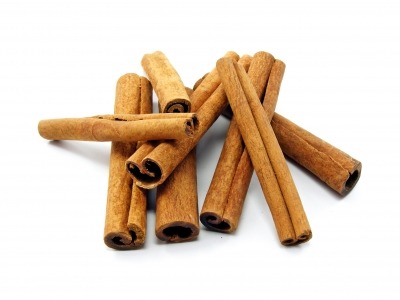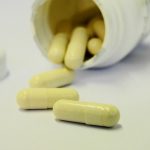
Cinnamon (dalchini) not only adds a distinctive, aromatic and pungent note to a variety of foods but extracts from this plant are claimed to lower fasting blood glucose levels, to increase glucose uptake and help in insulin management by triggering the cascade system. It clearly has been an important botanical for those ravaged by diabetes long hand as it were but the benefits are best described as modest. It also has benefits in heart health by helping to regulate blood sugar levels although this also needs qualifying. It appears to have antihyperglycaemic properties and could reduce postprandial blood glucose levels (Kirkham et al., 2009).
Cinnamon (Cinnamomum tamala Nees and Ebern.) and Ceylon cinnamon (Cinnamomum zeylanicum L.) family: Lauraceae are evergreen tropical trees which have been used for flavouring foods for hundreds of years. The bark appears to have been imported to Egypt from China as far back as 2000 B.C. It was found in the tomb of the Pharaoh Tutankhamun which attests to its importance. The Bible (both Exodus and Proverbs) mentions it as in Chinese texts over 4,000 years old.
The use of cinnamon must be judged carefully because it is such a pungent and characteristic spice. It is the characteristic note in biscuits such as biscotti. It is a critical ingredient in a number of Middle-Eastern and Indian spice mixes. Nowadays we might add it to tagines or sprinkle it on donuts or coffee even.
The main supply centers around the globe are Sri Lanka and plantations on the South East coast of India. A high quality cinnamon should have low levels of coumarin, even lower than cheap forms of Cassia.
Availability
If you are interested in purchasing the spice then you can access our affiliates. It comes in the form of either powder or rolled pieces of bark. Sources can be organic and should have at least some reference to our they are being sourced responsibly.
For US based products try these links
Please note this page contains links to our affiliate marketing partner. Please read our affiliate disclosure.
The main suppliers in the UK for example are:-
How To Use And Prepare
To make a comforting, sweet and spicy infusion simply add between 1/4 and 3/4 teaspoon to a cup of boiling water and enjoy up to three times a day. Also available in tablets, teas and essential oils. Sprinkle a little powdered cinnamon on to cuts and burns as an anti-septic.
Cautionary Information
- Never use cinnamon oil internally
- Do not use while pregnant or nursing
- Do not give infusions to children under two
- Cinnamon has been known to cause nausea so if experiencing any adverse effects reduce the amount or stop using it and consult your medical professional before proceeding.
The Components In Cinnamon
The inner bark or cinnamon cortex is used as the spice. The componentry covers various phenolics and a range of proanthocyanidins – oligomers and polymers of flavan-3-ol. Matrix-assisted laser desorption/ionization tandem time-of-flight (MALDI-TOF/TOF) mass spectrometry was used to identify new proanthocyanidins (Mateos-Martin et al., 2012a). This analysis was put to use in rat studies where the metabolites in their urine was found to be a variety of polymeric catechins with over 20 different phenolic acids. These presumably had free radical scavenging activity which were in contact with the intestinal walls for a number of hours following ingestion (Mateos-Martin et al., 2012).
Antioxidant Properties & Inflammation
Inflammation is a process used by the body to fight off infection and promote tissue repair following damage. However, inflammation is a major issue when it becomes a chronic condition (i.e. long-term) where the body attacks its own tissue. There is some research which suggests the antioxidants in cinnamon have anti-inflammatory properties (Rao and Gan, 2014).
Clinical Evidence
It has other affirmed health benefits – antibacterial, anti-inflammatory, antifungal and potent antioxidant properties. As well as gently ameliorating the effects of diabetes, cinnamon is also associated with lowering cholesterol levels.
Cinnamon has also been used in traditional medicine to improve heart function. An ethanolic extract of cinnamon bark was investigated for treatment of ischemia‐induced arrhythmias and heart injury in a live rat model for regional heart ischemia (Sedighi et al., 2018). Ischemia is the situation when blood flow to a tissue is stopped leading to tissue damage.
Improving Sensitivity To Insulin.
Cinnamon is understood to improve sensitivity to insulin. This key hormone is critical in regulating metabolism and energy expenditure. The hormone also helps modulate the transport of blood sugar in the bloodstream and then into cells that need such energy. One of the issues however is a resistance to the effects of insulin (Qin et al., 2010).
The references to diabetes mellitus are admirably covered by Pham et al., (2007), Gruenwald et al., (2010).
At the biochemical levels it might be that cinnamon compounds block the amyloid formation of hIAPP (human islet amyloid polypeptide) which when misfolded is a causative agent in type 2 diabetes mellitus (T2DM) (Jiao et al., 2013). There is also a suggestion that cinnamon extracts can ameliorate at the genetic level the harm of diabetes. Treatment of rats in a maze-learning activity were improved with cinnamon extract feeding because of the link to improvement in behaviour when reversing the effects of insulin insensitivity (Anderson et al., 2013).
It has also been associated with treatment for cancer and reducing infections.
References
Anderson, R.A., Qin, B., Canini, F., Poulet, L., Roussel, A.M (2013) Cinnamon Counteracts the Negative Effects of a High Fat/High Fructose Diet on Behavior, Brain Insulin Signaling and Alzheimer-Associated Changes. PLoS ONE 8(12): e83243. doi:10.1371/journal.pone.0083243
Gruenwald, J., Freder, J., Armbruester, N., (2010) Cinnamon and health. Crit. Rev. Food Sci. Nutr. 50 pp. 822–834.
Jiao, L.J., Zhang, X., Huang, L., Gong, H., Cheng, B., Sun, Y., Li, Y., Liu, Q., Zheng, L. Huang, K. (2013) Proanthocyanidins are the major anti-diabetic components of cinnamon water extract. Food Chem. Toxicol. 56 pp. 398-405
Kirkham S, Akilen R, Sharma S, Tsiami A. (2009) The potential of cinnamon to reduce blood glucose levels in patients with diabetes. Diabetes Obes. Metab. 11 pp. 1100–1113.
Mateos-Martín, M.L., Fuguet, E., Quero, C., Pérez-Jiménez, J., Torres, J.L. (2012a) New identification of proanthocyanidins in cinnamon (Cinnamomum zeylanicum L.) using MALDI-TOF/TOF mass spectrometry. Anal. Bioanal. Chem. 402, pp. 1327–1336
Mateos-Martín, M. L., Pérez-Jiménez, J., Fuguet, E. and Torres, J. L. (2012b) Profile of urinary and fecal proanthocyanidin metabolites from common cinnamon (Cinnamomum zeylanicum L.) in rats. Mol. Nutr. Food Res., 56 pp. 671–675. doi: 10.1002/mnfr.201100672
Pham, A.Q., Kourlas, H., Pham, D.Q. (2007) Cinnamon supplementation in patients with type 2 diabetes mellitus. Pharmacotherapy 27 pp. 595–599
Qin, B., Panickar, K.S., Anderson, R.A. (2010) Cinnamon: Potential Role in the Prevention of Insulin Resistance, Metabolic Syndrome, and Type 2 Diabetes. Journal of Diabetes Science and Technology. 4(3) pp. 685-693 (Article)
Rao, P.V., Gan, S.H. (2014) Cinnamon: A Multifaceted Medicinal Plant. Evidence-based Complementary and Alternative Medicine : eCAM. 2014;2014:642942. doi:10.1155/2014/642942. (Article)



Leave a Reply